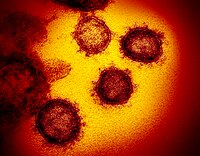
Photo from wikipedia
Severe acute respiratory syndrome coronavirus 2 (SARS-CoV-2) encodes the papain-like protease (PLpro). The protein not only plays an essential role in viral replication but also cleaves ubiquitin and ubiquitin-like interferon-stimulated… Click to show full abstract
Severe acute respiratory syndrome coronavirus 2 (SARS-CoV-2) encodes the papain-like protease (PLpro). The protein not only plays an essential role in viral replication but also cleaves ubiquitin and ubiquitin-like interferon-stimulated gene 15 protein (ISG15) from host proteins, making it an important target for developing new antiviral drugs. In this study, we searched for novel, noncovalent potential PLpro inhibitors by employing a multistep in silico screening of a 15 million compound library. The selectivity of the best-scored compounds was evaluated by checking their binding affinity to the human ubiquitin carboxy-terminal hydrolase L1 (UCH-L1), which, as a deubiquitylating enzyme, exhibits structural and functional similarities to the PLpro. As a result, we identified 387 potential, selective PLpro inhibitors, from which we retrieved the 20 best compounds according to their IC50 values toward PLpro estimated by a multiple linear regression model. The selected candidates display potential activity against the protein with IC50 values in the nanomolar range from approximately 159 to 505 nM and mostly adopt a similar binding mode to the known, noncovalent SARS-CoV-2 PLpro inhibitors. We further propose the six most promising compounds for future in vitro evaluation. The results for the top potential PLpro inhibitors are deposited in the database prepared to facilitate research on anti-SARS-CoV-2 drugs.
Journal Title: International Journal of Molecular Sciences
Year Published: 2021
Link to full text (if available)
Share on Social Media: Sign Up to like & get
recommendations!